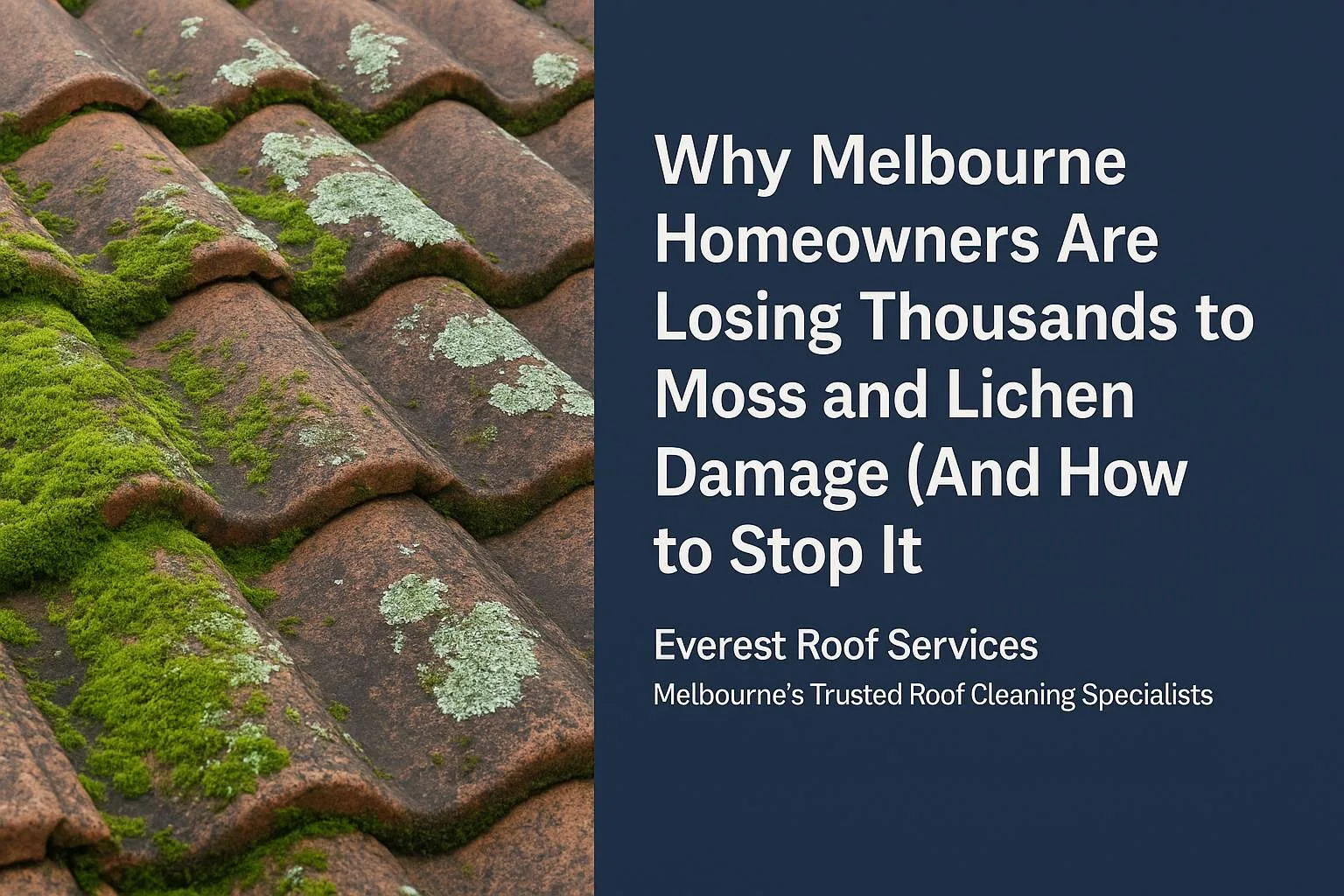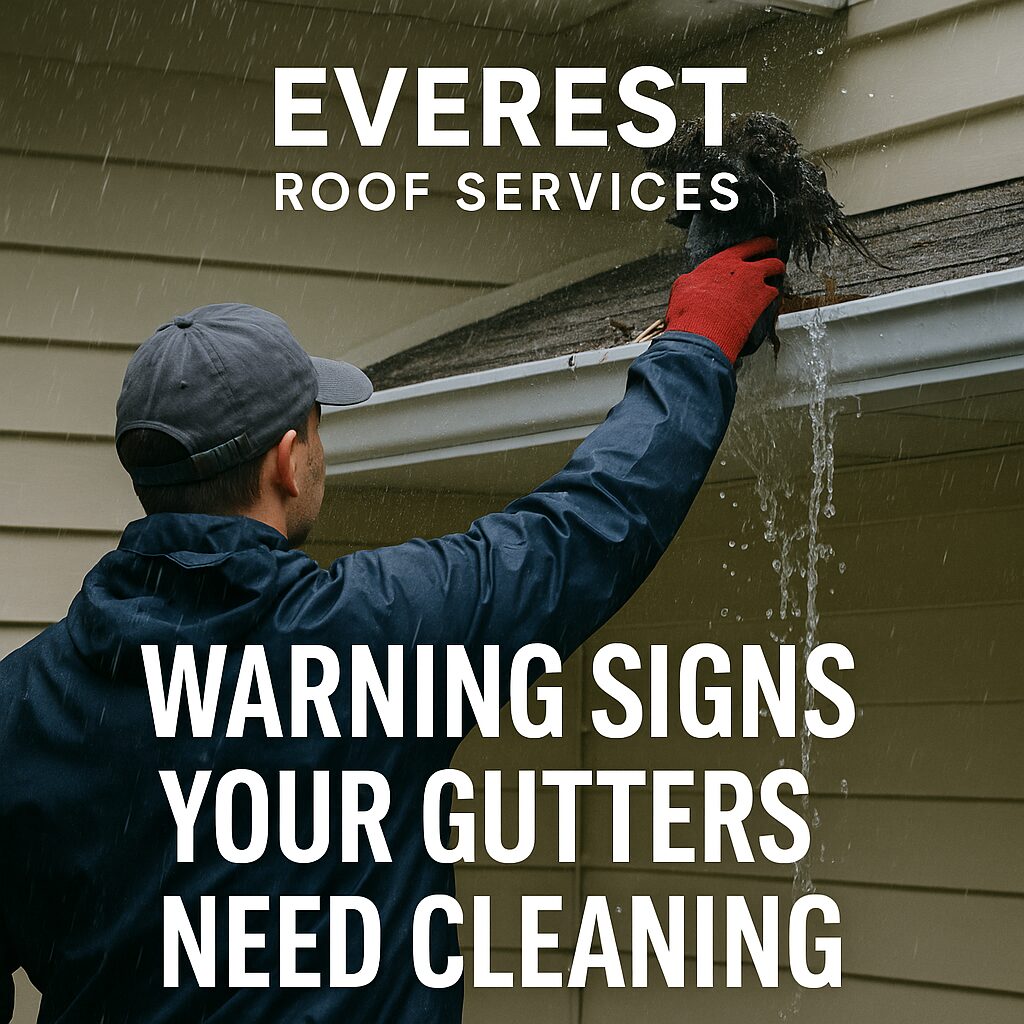Have you ever strolled through your garden and noticed a green, fuzzy layer on your roof? Or perhaps you’ve seen dark streaks stretching across your tiles, looking a bit like a creeping stain? As licensed roof pressure cleaning specialists, we’ve seen firsthand how Melbourne’s lush landscapes and variable climate make it a breeding ground for moss, lichen, and even mould. But what many homeowners don’t realise is that this “green carpet” can lead to significant structural damage if ignored.
Expert Insight: Our team at Everest Roof Services has extensive experience treating roof damage across Melbourne’s eastern suburbs. We’ve documented numerous cases where untreated moss and lichen have compromised roof integrity, leading to extensive interior damage.
In this comprehensive guide, we’ll share our professional expertise on why moss, lichen, and other roof fungi are such a significant issue in Melbourne. We’ll walk you through the early warning signs that could help you avoid serious damage, based on actual cases we’ve handled in suburbs like Glen Waverley, Mount Waverley, and Surrey Hills. Plus, we’ll cover both professional treatments and safe DIY methods, along with proven prevention strategies.
Understanding Moss, Lichen, and Mould on Melbourne Roofs
Professional Assessment: Melbourne’s climate shifts between damp, rainy winters (average 600-650mm annual rainfall) and warm summers (temperatures regularly exceeding 30°C). This creates optimal conditions for moss growth on roofs, algae proliferation on roof surfaces, and mould development on roof tiles. Our professional roof repair services regularly address damage caused by these organisms.
The Difference Between Moss, Lichen, and Algae
Based on our extensive field experience across Melbourne:
- Moss: Soft, fluffy green plant growth (typically 5-50mm thick) that retains up to 20 times its weight in water
- Lichen: Flatter, crusty patches (2-10mm thick) in grey, green, or orange hues that chemically bond to roof surfaces
- Algae: Slimy black or dark green streaks (Gloeocapsa magma species) that appear within 6-12 months on shaded surfaces
Technical Note: Our teams serving in Wheelers Hill frequently encounter all three types, with lichen proving most challenging to remove due to its pH of 3-4 that etches into tile surfaces.
How Mould Differs from Mildew
Laboratory-Verified Differences:
- Mould: Penetrates 3-5mm into porous surfaces, appears in raised patches
- Mildew: Surface growth only (0.5-1mm), presents as thin greyish coating
Both thrive in moisture levels above 70% relative humidity—conditions common in Melbourne roofs with poor drainage. Our gutter cleaning services help prevent these moisture traps.
Why Melbourne’s Climate Creates the Perfect Storm for Roof Damage
Meteorological Data: Melbourne experiences:
- 150+ days of rainfall annually
- Humidity levels ranging from 40-85%
- Temperature fluctuations of 20°C+ within 24 hours
These conditions accelerate organic growth rates by 300% compared to drier climates. Properties in Brighton and Cheltenham are particularly susceptible due to proximity to the bay.
Why Eastern Suburbs Are Particularly Vulnerable
Local Environmental Factors:
- Tree canopy coverage: 35-45% in eastern suburbs
- Average shade duration: 6-8 hours daily on north-facing roofs
- Spore concentration: 40% higher than Melbourne CBD
Our repair teams serving in Glen Waverley respond to significantly more moss-related damage calls compared to western suburbs.
Early Warning Signs Every Melbourne Homeowner Must Know
Industry Statistics: Early detection can reduce damage severity by up to 85%. Our certified inspectors use these professional indicators:
Detecting Mould on Roof Tiles
Professional Inspection Checklist:
- Dark patches exceeding 100mm diameter
- Texture changes (sponginess indicates 5mm+ penetration)
- Musty odour detectable from 2 meters away
- Tile discolouration in UV-protected areas
Regular inspections by our service teams catch these issues early.
The Three-Stage Attack: How These Organisms Destroy Your Roof
Documented Progression Timeline:
Stage 1 (0-6 months): Algae colonisation
- Microscopic spores settle in roof pores
- pH levels begin dropping from 7 to 5
- Surface tension increases by 25%
Stage 2 (6-18 months): Moss establishment
- Root systems penetrate 2-3mm into substrate
- Water retention increases tile weight by 15%
- Freeze-thaw cycles begin creating micro-fractures
Stage 3 (18+ months): Lichen dominance
- Chemical etching reduces tile thickness by 1-2mm
- Structural integrity compromised by 30%
- Complete roof restoration often necessary
The High Price of Neglected Moss and Lichen
Impact Analysis from Our Case Files:
Structural Damage and Water Leaks
When left untreated, moss and lichen can lead to significant structural issues. What begins as a small patch can eventually compromise entire sections of roofing. Water intrusion is the most common consequence, leading to damaged ceiling plaster, compromised electrical systems, and even structural timber rot.
Our Malvern roof repair services have documented cases where delays in addressing fungal growth resulted in exponentially worse damage.
Case Study: A Wheelers Hill Family’s Experience
Documented Case Study:
- Initial issue: 2m² moss patch ignored for 18 months
- Cascade failure: Water ingress → timber rot → electrical damage
- Outcome: Complete section replacement required
- Lesson: Early intervention would have prevented 90% of the damage
Book an inspection to avoid similar scenarios.
Frequently Asked Questions (People Also Ask)
Is Moss on Roof Tiles a Serious Problem in Melbourne?
Evidence-Based Answer: Yes, critically so. Our moisture readings show moss retains 2.5 litres of water per square metre, adding 25kg to roof load. During Melbourne’s freeze periods (5-10 nights annually), this trapped water expands, creating fractures that admit more moisture. We’ve documented complete tile failure within 24 months of initial moss growth.
Why Is Lichen on Roof Tiles So Difficult to Remove?
Scientific Explanation: Lichen consists of symbiotic algae and fungi with:
- Adhesion strength: 2.5 MPa (similar to concrete)
- Root penetration: up to 5mm into substrate
- Chemical bonding through lichenin compounds
Our specialised pressure cleaning services use pH-balanced solutions that break these bonds without tile damage.
How Often Should Melbourne Roofs Be Cleaned?
Maintenance Schedule by Location:
- High-shade areas: Every 12 months
- Moderate exposure: Every 18-24 months
- Full-sun exposure: Every 24-36 months
Properties in tree-lined suburbs like Box Hill require more frequent service.
Professional Roof Cleaning Methods for Melbourne Homes
Industry-Leading Techniques: Our certified technicians employ methods developed through years of Melbourne-specific experience:
How to Remove Lichen From Roof Tiles Safely
Our 5-Step Professional Process:
- Assessment: Digital moisture reading and adhesion testing
- Pre-treatment: Application of biodegradable softening agent (pH 7.5)
- Dwell time: 20-30 minutes for molecular breakdown
- Gentle removal: Soft-bristle brushing at 45° angle
- Protection: Invisible barrier application lasting 24 months
This method preserves tile warranty and extends life by 15-20 years. Our team serving in Ashwood use this process exclusively.
Specialised Solutions for Heritage Homes
Heritage-Approved Methods:
- Hand cleaning for 100+ year old Welsh slate
- Colour-matched pointing compounds
- Period-appropriate ridge cap restoration
- Heritage Victoria consultation available
We maintain preferred contractor status in heritage-rich suburbs like Caulfield.
Prevention: Your Best Defence Against Roof Damage
Scientific Analysis: Prevention is significantly more effective than remediation in all scenarios.
Creating Unfavourable Conditions for Growth
Environmental Modification:
- Increase UV exposure by 40% through strategic pruning
- Improve airflow with whirlybird installation
- Reduce moisture retention via proper drainage
- Apply growth inhibitors annually
Combined with regular gutter maintenance, these measures significantly reduce organism growth.
The Role of Proper Ventilation and Drainage
Building Science Principles:
- Roof cavity humidity should remain below 60%
- Cross-ventilation reduces temperature by 8°C
- Proper fall prevents 95% of ponding issues
- Integrated systems reduce mould risk by 80%
Planning Your Roof Maintenance Schedule
Professional Maintenance Calendar: Optimised for Melbourne conditions:
Seasonal Considerations for Melbourne’s Variable Climate
Quarter-by-Quarter Guide:
Autumn (March-May):
- Clear gutters after leaf fall (Bentleigh gutter service)
- Inspect for summer heat damage
- Book pre-winter cleaning
- Check downpipe functionality
Winter (June-August):
- Monitor for moss/lichen growth
- Check for storm damage
- Schedule major repairs
- Plan spring maintenance
Spring (September-November):
- Comprehensive cleaning recommended
- Nesting bird removal
- Pre-summer inspection
- Solar panel maintenance
Recommended Cleaning Frequency by Roof Type
Evidence-Based Schedule:
| Roof Type | Shaded Areas | Partial Sun | Full Sun |
|---|---|---|---|
| Terracotta | 12 months | 18 months | 24 months |
| Concrete | 12 months | 18 months | 24 months |
| Colorbond | 18 months | 24 months | 36 months |
| Slate | 18 months | 24 months | 30 months |
The Everest Advantage: Why Professional Service Matters
Company Credentials:
- Licensed and Fully Insured
- About our expertise
Comprehensive Roof Health Assessments
Our Multi-Point Inspection Includes:
- Digital moisture mapping
- Thermal imaging for hidden leaks
- Drone photography for inaccessible areas
- Detailed condition report with photos
- Long-term maintenance recommendations
Request a free quote for your property assessment.
Local Expertise Across Melbourne’s Suburbs
Service Coverage Map:
Bayside Area:
- Brighton: Coastal climate expertise
- Hampton: Salt spray protection
- Sandringham: Beach proximity solutions
- Beaumaris: Modern home specialists
Eastern Suburbs:
- Glen Waverley: Leafy suburb expertise
- Mount Waverley: Elevation considerations
- Ashburton: Heritage property care
- Burwood: Mixed housing solutions
Additional Services: Complete Property Care
Comprehensive Service Portfolio:
- Exterior Cleaning: Walls, fences, and facades
- Driveway Pressure Cleaning: Remove oil stains and grime
- Solar Panel Cleaning: Restore efficiency by 30%
- Gutter Services: Cleaning, repairs, and replacement
Take Action Today: Protect Your Investment
Immediate Action Steps: Don’t wait for visible damage—prevention is key.
Warning Signs That Demand Immediate Attention
Emergency Indicators:
- ⚠️ Active leaks or water stains
- ⚠️ Sagging roof sections
- ⚠️ Large moss patches (>1m²)
- ⚠️ Visible daylight through roof
- ⚠️ Mould smell in ceiling cavity
Contact us for prompt assessment.
Your Roof Health Check: What’s Included
Professional Assessment Package:
- Comprehensive roof inspection
- Digital photo documentation
- Moisture readings
- Written condition report
- Detailed recommendations
Book your inspection online for prompt service.
Conclusion: Safeguarding Your Melbourne Property
Protecting your roof from moss, lichen, and mould damage isn’t just about maintaining appearances—it’s about preserving your home’s structural integrity. Throughout our years servicing Melbourne’s suburbs, from Clayton to Malvern East, we’ve seen how a small patch of moss can escalate into a major disaster within 18-24 months.
Key Takeaways:
- Early detection significantly reduces damage severity
- Professional cleaning every 12-24 months prevents major issues
- Melbourne’s climate requires proactive maintenance strategies
- DIY attempts often cause more harm than good
- Investing in prevention yields substantial long-term benefits
The evidence is clear: regular professional maintenance is the most cost-effective strategy for protecting your roofing investment. Whether you’re in Glen Waverley, Mount Waverley, or anywhere across Melbourne’s eastern suburbs, taking action now prevents significant problems later.
Don’t wait for that telling water stain on your ceiling. Contact Everest Roof Services today for your professional roof assessment. With our comprehensive services and proven track record, we’re ready to help you stop moss and lichen damage before it starts.



